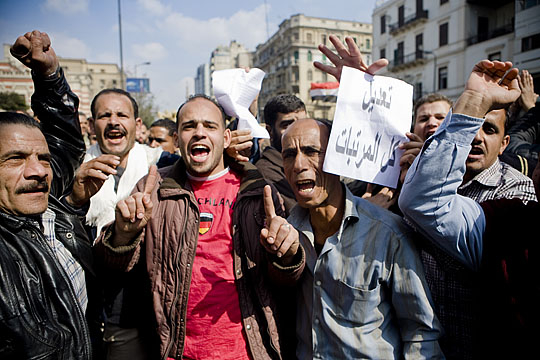Egyptian Workers: ‘It’s Not Finished’

As Egyptian citizens celebrate their first victory on the way to democracy, worker organizers looked to continue the wave of organizing that led to dozens of strikes in the regime’s last days and afterward.
Abdel Hafiz, a leader of the new Independent School Teachers Trade Union, said, “When the revolution started its aims were only for political reform—a new constitution, political democracy, the right to organize. Now it’s going to our other social claims, for the salaries. This will go and that will go, side by side.”
The Egyptian military had other ideas, as tens of thousands of public workers demonstrated for raises.
The generals told strikers to go back to work, warning they could harm the economy and create the wrong “climate.” Although the protesters have expressed faith that the army will support their revolution, the generals’ tolerance may not extend to strikes and unions.
More than 20,000 workers had walked out on February 9, two days before Mubarak resigned. Kamal Abbas, director of the Center for Trade Union and Workers Services in Cairo, told Labor Notes, “This day in the revolution could be named for the labor unions.”

And the strikes spread, starting with Suez Canal workers, railroad workers, hospital and factory workers. The AFL-CIO Solidarity Center reported on February 11 that 24,000 textile workers at a government-owned factory were demanding raises. Military equipment factories, subway workers, postal workers, airline and hospital workers all walked out.
On February 14, reports put steel, textile, telecom, railroad, postal, bank, oil, pharmaceutical, health, culture, and transport workers all out. Even the hated police demonstrated for higher pay.
YEARS OF WORKER ACTIONS
The explosion of strikes didn’t just suddenly appear. Workers were continuing a strike wave that escalated in 2004 when the “government of businessmen” accelerated privatization.
Egyptian Textile Strike in 2008 Attracted Students, Gave Birth to ‘April 6’ Movement
The unrest in Egypt in some ways can be traced to the attempt of workers at the state-run textile factories of al-Mahalla al-Kubra just outside Cairo to launch a major strike on April 6, 2008. The idea spread elsewhere in the country, promoted by computer-literate working class youths and their supporters among middle-class college students.
A Facebook page set up to promote the strike attracted tens of thousands of followers. The authoritarian state mobilized to break the strike, infiltrating the factories with plainclothes security men, lining streets in downtown Cairo and elsewhere with phalanxes of riot police, and warning strikers and their supporters of three years in prison for participating.
The fundamentalist party, the Muslim Brotherhood, which skews to the right on social issues, declined to support the movement, and lost credibility with many of the youths as a result.

SUPPORT LABOR NOTES
BECOME A MONTHLY DONOR
Give $10 a month or more and get our "Fight the Boss, Build the Union" T-shirt.
Although the regime had some success in forestalling a successful outcome that time, an “April 6 Committee” of youths and labor activists was formed and continued to plan and agitate. They were among the major forces calling for the big demonstration on January 25 at Tahrir Square that brought down the Egyptian cabinet.
Since then, more than two million Egyptian workers had struck, sat down, and protested. For comparison, imagine if 8 million Americans had struck over the course of the last six years.
Abbas said the country saw 3,000 strikes in both government and private sectors.
“Of course, these actions were making economic demands—higher pay,” he said.
They were highly effective, too. Ninety percent led to increased pay packets, according to the prime minister. The minimum wage was about $60 a month in 2010, up from a dismally low $6 a month.
Those strikes were all self-organized, in defiance of the official government-controlled unions in the Egyptian Trade Union Federation (ETUF). And workers learned that it was possible to protest: “There’s no question that that pattern led to involving and breaking the fear for the rest of the people, among them more workers,” Abbas said.
Abbas’s group, the CTUWS, was formed in 1990 to help workers organize despite repression and the heavy hand of the ETUF, which has been the only legal union.
When protests jumped off this year, Abbas said, the ETUF leaders were “still on the side of Mubarak. But they have disappeared.”
NEW WORKERS’ FEDERATION
Just five days after the protests began on January 25, two existing independent unions—of municipal tax collectors and health technicians—proclaimed the new Federation of Egyptian Trade Unions .
The federation, also founded by CTUWS and a retirees organization, was immediately recognized by the AFL-CIO, the International Labor Organization of the UN, and the International Trade Union Confederation. The AFL-CIO gave CTUWS and the tax collectors its Human Rights award in 2009.
With 7 million people unemployed, out of a population of 80 million, 40 percent of the people at or near the poverty line, and persistent inflation, Egyptian workers have years of pent-up demands and frustration that may not be easily calmed by the promise of a new constitution.


